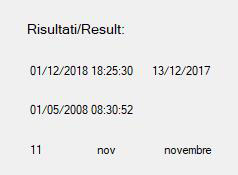D1. Calcolare il tempo di esecuzione di un’applicazione
Con TimeSpan
Inserire il contenuto del Button1 all’inizio dell’app da controllare e il contenuto del Button2 alla fine.
D2. Impostare l’orario di esecuuzione di un’attività
Inserire in Form1: 5 Label, 1 Button, 2 NumericUpDown e un Timer.
Con StopWatch
Nell’esempio il programma da misurare è il ciclo For…Next
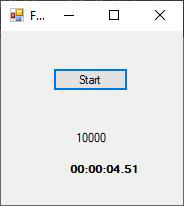
D1. Calculate the execution
time implementation of an
application
In the example the program to
measure is the cycle For...Next


Time & Timer
2. Setting the execution time
of an activity
Add in Form1: 5 Label, 1 Button, 2
NumericUpDown and a Timer.
Public Class Form1
Dim ora As Integer
Dim minuto As Integer
Private Sub Timer1_Tick(sender As Object, e As EventArgs) Handles Timer1.Tick
Dim currhour As Integer
Dim currminute As Integer
Dim time As Date = Date.Now
currhour = time.Hour
currminute = time.Minute
Label3.Text = "ora corrente"
Label4.Text = currhour.ToString & " : " & currminute.ToString & "'"
If currhour = ora AndAlso currminute = minuto Then
Label5.Text = "E' giunta l'ora"
Timer1.Stop()
End If
End Sub
Private Sub Button1_Click(sender As Object, e As EventArgs) Handles Button1.Click
Timer1.Start()
ora = NumericUpDown1.Value
minuto = NumericUpDown2.Value
End Sub
End Class
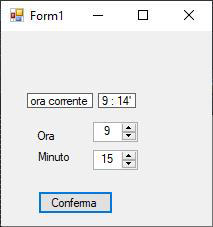
1. Calcolare il tempo di esecuzione di un’applicazione
2. Schedulare un’attività
3. Crea pausa di XX secondi
4. Contasecondi
5. Giorni fra due date
6. Calcola nuova data sulla base dei giorni aggiunti o tolti
7. Converte numero e stringa in data
Public Class Form1
Dim stopWatch As New Stopwatch()
Private Sub Button1_Click(sender As Object, e As EventArgs) Handles Button1.Click
Label1.Text = ""
Label2.Text = ""
stopWatch.Reset() 'Riporta a zero il tempo trascorso
stopWatch.Start()
For i = 0 To 10000
Label2.Text = i
Application.DoEvents()
Next
stopWatch.Stop()
Dim ts As TimeSpan = stopWatch.Elapsed
Dim elapsedTime As String = String.Format("{0:00}:{1:00}:{2:00}.{3:00}", ts.Hours,
ts.Minutes, ts.Seconds, ts.Milliseconds / 10)
Label1.Text = String.Format("{0:00}:{1:00}:{2:00}.{3:00}", ts.Hours, ts.Minutes, ts.Seconds,
ts.Milliseconds / 10)
'Label1.Text = String.Format("{0:00}:{1:00}", ts.Minutes, ts.Seconds) 'Mostra solo i minuti e i secondi
End Sub
End Class
Dim tp1 As String
Dim ts1, ts2, intervallo As New TimeSpan
Dim tempo As String
Label1.Text = ("00:00")
Button2.Enabled = True
ts1 = New TimeSpan(Now.Ticks)
‘Qui inserire l’attività di cui volete misusrare il tempo di esecuzione
‘Here enter the activity you want to measure the execution time for
'Acquisisce il tempo finale e fa la differenza fra i due tempi
ts2 = New TimeSpan(Now.Ticks)
intervallo = ts2 - ts1
tempo = intervallo.ToString.Substring(3, 5)
Label1.Text = tempo
Button2.Enabled = False
D3. Crea pausa di xx secondi
Inserire in Form1: 2 Label, 4 Button, 1 TextBox
Nota: Utilizzando Thread.Sleep l'applicazione rimane congelata fino alla fine della pausa
----1° Esempio
Sub Button1_Click(sender As Object, e As EventArgs) Handles Button1.Click
TextBox1.Clear()
Application.DoEvents()
wait(5)
End Sub
Private Sub wait(ByVal pausa As Integer)
For i As Integer = 0 To pausa * 10
Threading.Thread.Sleep(100)
TextBox1.Text = "Pausa 5 sec."
Next
End Sub
------2° Esempio
Private Sub Button2_Click(sender As Object, e As EventArgs) Handles Button2.Click
TextBox1.Clear()
Application.DoEvents()
wait2()
End Sub
Private Sub wait2()
Dim intervallo As TimeSpan = New TimeSpan(0, 0, 2)
For i As Integer = 0 To 5 - 1
Threading.Thread.Sleep(intervallo)
TextBox1.AppendText("pausa 2 sec." & vbCr)
Next
End Sub
------3° Esempio
'Fa una pausa di 4 secondi e indica il tempo trascorso
Private Sub Button3_Click(sender As Object, e As EventArgs) Handles Button3.Click
Dim stopWatch As Stopwatch = New Stopwatch()
Dim pausa As Integer = 4
stopWatch.Start()
Threading.Thread.Sleep(pausa * 1000)
stopWatch.[Stop]()
Dim ts As TimeSpan = stopWatch.Elapsed
Label1.Text = ts.ToString.Substring(0, 8)
End Sub
-------4° Esempio
Private Sub Button4_Click(sender As Object, e As EventArgs) Handles Button4.Click
Wait3(6)
End Sub
'Questa sub attende per il tempo richiesto senza congelare l'applicazione nella quale è inserita.
Inserendo BreakCondition nel loop è possibile interromperlo.
Private Sub Wait3(ByVal Seconds As Double, Optional ByRef BreakCondition As Boolean = False)
Dim attendi As Date
attendi = Now.AddSeconds(Seconds)
Do Until Now > attendi
Application.DoEvents()
Loop
Label2.Text = ("pausa " & Seconds & " sec.")
End Sub
3. Create xx seconds pauses
Add in Form1: 2 Label, 4 Button, 1
TextBox
With Thread.Sleep, the application
remains frozen until the end of the
pause.
D4. Contasecondi
Esempio con TimeSpan
Inserire in Form1: 3 Button, 1 Label e 1 Timer
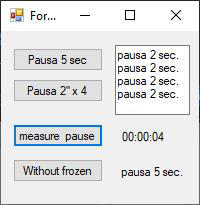
This sub waits for the required time
without freezing the application in
which it is inserted
4. Timer
Add in Form1: 1 Label, 3 Button, 1
Timer
Example with TimeSpan
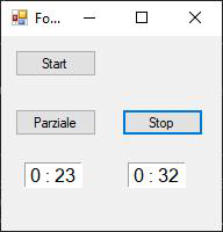
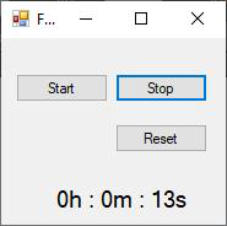
Dim tspn As New TimeSpan()
Private Sub Timer1_Tick(sender As Object, e As EventArgs) Handles Timer1.Tick
tspn = tspn.Add(New TimeSpan(0, 0, 1))
Label1.Text = String.Format("{0}h : {1}m : {2}s", tspn.Hours, tspn.Minutes, tspn.Seconds)
End Sub
Private Sub Button1_Click(sender As Object, e As EventArgs) Handles Button1.Click
Timer1.Start()
End Sub
Private Sub Button2_Click(sender As Object, e As EventArgs) Handles Button2.Click
Timer1.Stop()
End Sub
Private Sub Button3_Click(sender As Object, e As EventArgs) Handles Button3.Click
tspn = New TimeSpan(0, 0, 0)
Label1.Text = "0h : 0m : 0s"
End Sub
Esempio con Elapsed.Minute
Inserire in Form1: 3 Button, 2 Label e 1 Timer
Dim conteggio As New System.Diagnostics.Stopwatch()
Dim parziale As Boolean = True
Private Sub Button1_Click(sender As Object, e As EventArgs) Handles Button1.Click
Timer1.Start()
conteggio.Start()
Label2.Visible = False
End Sub
'Intertempo-First step
Private Sub Button2_Click(sender As Object, e As EventArgs) Handles Button2.Click
parziale = False
Label2.Visible = True
End Sub
'Tempo Finale- Final time
Private Sub Button3_Click(sender As Object, e As EventArgs) Handles Button3.Click
Timer1.Stop()
conteggio.Stop()
End Sub
Private Sub Timer1_Tick(sender As Object, e As EventArgs) Handles Timer1.Tick
If parziale = True Then
Label1.Text = conteggio.Elapsed.Minutes.ToString & " : " & conteggio.Elapsed.Seconds.ToString
End If
Label2.Text = conteggio.Elapsed.Minutes.ToString & " : " & conteggio.Elapsed.Seconds.ToString
End Sub
Example with Elapsed.Minute
Insert in Form1: 3 Button, 2 Label and
1 Timer
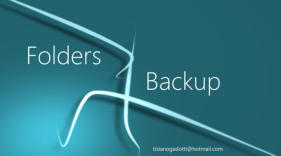
Folders
Backup
è
un’efficiente
applicazione
per
il
salvataggio
di
cartelle
o
intere partizioni*.
Offre
quanto
serve
per
garantire
una
corretta
gestione
dei
backup
con
una
notevole
semplicità
d’uso
e
un’interfaccia
che
permette
un’impostazione
alla
portata
dei
meno
esperti
e
che
fornisce
subito
tutte
le
informazioni
necessarie
per
avere
una
chiara
visione dello stato dei propri backups.
Folders
Backup
is
an
efficient
application
for saving folders or entire partitions*.
It
offers
everything
you
need
to
ensure
proper
backup
management
with
a
remarkable
ease
of
use
and
an
interface
that
allows
an
easy
and
proper
setting
and
provides
all
the
information
you
need
to
have
a clear view of the status of your backups.


1. Calculate the execution time of an application
2. Schedule an activity
3. Create XX seconds pause
4. Seconds counter
5. Days between two dates
6. Calculate new date
7. Converte numero e stringa in data
Un esempio: usare TimeSpan per calcolare
la durata di un viaggio
An example: using TimeSpan to calculate
the duration of a trip
Dim Partenza As DateTime = New
DateTime(2020, 5, 10, 18, 30, 0)
Dim Arrivo As DateTime = New
DateTime(2020, 5, 12, 20, 45, 10)
Dim DurataViaggio As TimeSpan =
Arrivo.Subtract(Partenza)
Label1.Text = (DurataViaggio.Days & "
Giorni, " & DurataViaggio.Hours & " Ore, " &
DurataViaggio.Minutes & " Minuti")
Risulta
Result:
TimeSpan calcola un intervallo di tempo in
giorni, ore, minuti, secondi e frazioni di
secondo indipendentemente dalla data nel
qual caso occorre utilizzare la struttura
DateTime
TimeSpan calculates a time interval in days,
hours, minutes, seconds and fractions of a
second regardless of the date in which case
the DateTime structure must be used.

D5. Giorni fra due date
Inserire in Form1: 1 Button, 6 Label e 2 DateTimePicker
Private Sub Button1_Click(sender As Object, e As EventArgs) Handles Button1.Click
Dim date1 As Date = Date.Now
Dim date2 As Date '= date1.AddDays(365.0#)
Dim dateOne = DateTimePicker1.Value
Dim dateTwo = DateTimePicker2.Value
Dim diff As TimeSpan = dateTwo.Subtract(dateOne)
Dim years As Double = diff.TotalDays / 365
Label11.Text = years.ToString("0.00")
Label12.Text = (years * 12).ToString("0.00")
Label13.Text = diff.TotalDays.ToString("0.00")
End Sub
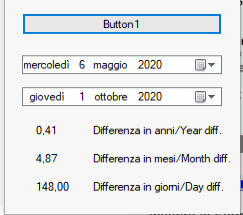
5. Days between two dates
Add in Form1: 1 Button, 6 Label and
2 DateTimePicker
D6. Calcola nuova data
Inserire in Form1: 1 Button, 10 Label e 1 TextBox
Calcola una nuova data sulla base dei giorni aggiunti o tolti
D6. Calculate new date
Add in Form1: 1 Button, 10 Label e 1
TextBox
Calculate a new date based on days
added or removed
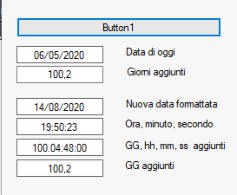
Private Sub Form1_Load(sender As Object, e As EventArgs) Handles MyBase.Load
Label1.Text = Today
TextBox1.Text = 100.2
End Sub
Private Sub Button1_Click(sender As Object, e As EventArgs) Handles Button1.Click
Dim date1 As Date = Date.Now
Dim date2 As Date '= date1.AddDays(365.0#)
date2 = date1.AddDays(TextBox1.Text)
Label4.Text = (date2.ToString("dd/MM/yyyy"))
Dim diff = date2 - date1 '
Dim giorni As Double = diff.TotalDays
Label7.Text = diff.ToString
Label5.Text = date2.ToString.Substring(11, 8)
Label9.Text = giorni
End Sub
D7. Converte numero e stringa in data
Imports System.Globalization as Namespace
D7. Convert number and
string to date
'Converte numero in data/Converte numero in data
Dim anno As Integer = 2018
Dim mese As Integer = 12
Dim giorno As Integer = 1
Dim ora As Integer = 18
Dim minuti As Integer = 25
Dim secondi As Integer = 30
Dim date1 As New Date(anno, mese, giorno, ora, minuti, secondi)
Dim date2 As Date = #12/13/2017# 'Mese/Giorno/Anno
Label1.Text = date1
Label2.Text = date2
'Converte stringa in data/Convert string to date
Dim dateString As String = "5/1/2008 8:30:52 AM"
Dim date0 As Date = Date.Parse(dateString, CultureInfo.InvariantCulture) 'Converte il testo in data
Label3.Text = date0
'Converte numero in mese/Convert number in month
Label6.Text = "11"
Dim intero As Integer = Label6.Text
Dim nameAbb As String = MonthName(intero)
Dim name As String = MonthName(intero, True)
Label4.Text = name
Label5.Text = nameAbb
